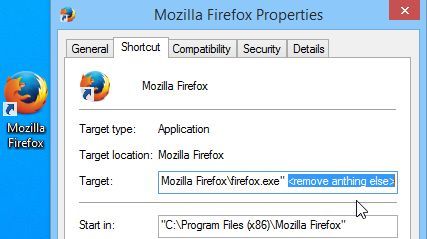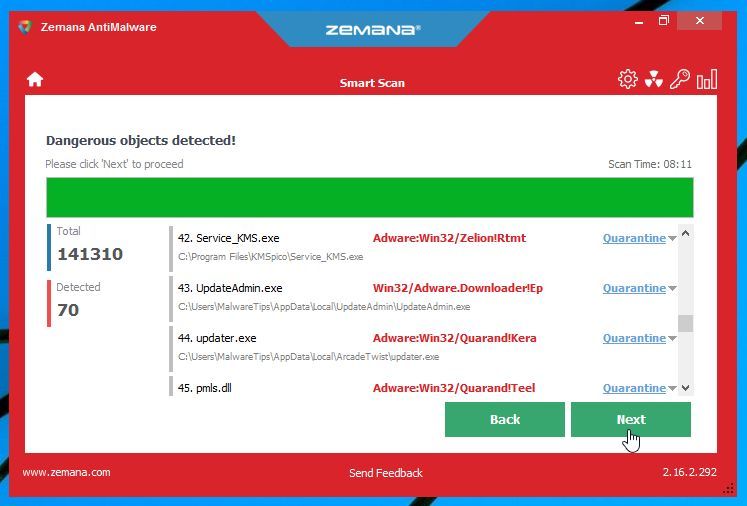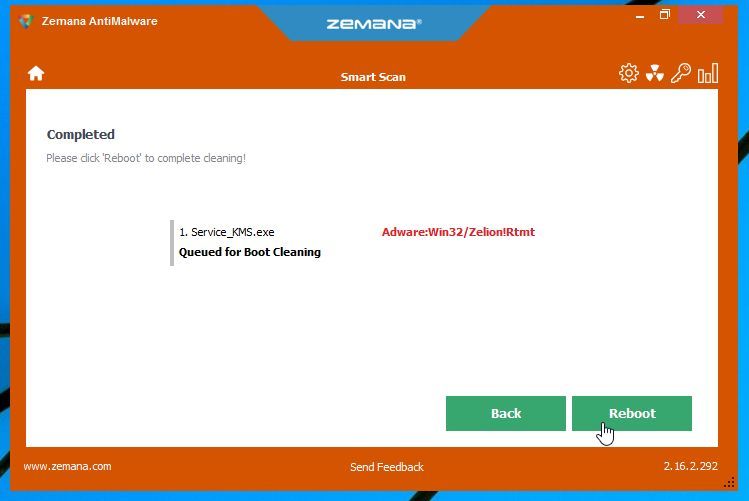If you are seeing random pop-up ads from Vicevice.com whenever you start up your computer, then your machine is infected with an adware or a potentially unwanted program.
The Vicevice.com pop-ups are caused by an adware program, which is distributed through various monetization platforms during installation. This type of adware is typically added when you install another free software (video recording/streaming, download-managers or PDF creators) that had bundled into their installation this adware program.
When the Vicevice.com adware is installed on your computer, whenever Windows will start, an ad from Vicevice.com will pop-up. Other common symptoms include:
- Advertising banners are injected with the web pages that you are visiting.
- Random web page text is turned into hyperlinks.
- Browser popups appear which recommend fake updates or other software.
- Other unwanted adware programs might get installed without the user’s knowledge.
This adware program modifies Windows registry by adding a cmd.exe command which runs every time Windows starts. Secondly, it creates a start-up entry. As a result, black cmd.exe window pops up and opens the gangnamgame.org web page which redirects you to Vicevice.com. The whole Windows registry modification looks like this:
Command: cmd.exe /c start http://vicevice.com&& exit
Location: HKLM\SOFTWARE\Wow6432Node\Microsoft\Windows\CurrentVersion\Run
You should always pay attention when installing software because often, a software installer includes optional installs, such as this program that is causing the Vicevice.com redirect. Be very careful what you agree to install.
Always opt for the custom installation and deselect anything that is not familiar, especially optional software that you never wanted to download and install in the first place. It goes without saying that you should not install software that you don’t trust.
How to remove Vicevice.com pop-up ads (Virus Removal Guide)
This page is a comprehensive guide, which will remove Vicevice.com virus from your computer and any other adware program that may have been installed during the setup process.
Please perform all the steps in the correct order. If you have any questions or doubt at any point, STOP and ask for our assistance.
STEP 1: Remove Vicevice.com start-up key from Windows with Ccleaner
STEP 2: Remove Vicevice.com adware with AdwCleaner
STEP 3: Remove Vicevice.com pop-up virus with Malwarebytes Anti-Malware
STEP 4: Remove with Vicevice.com browser hijacker with HitmanPro
STEP 5: Clean up the various Windows shortcuts that have been hijacked by vicevice.com virus
(OPTIONAL) STEP 6: Double-check for the Vicevice.com malware infection with Zemana AntiMalware
STEP 1 : Remove Vicevice.com start-up key from Windows with Ccleaner
- You can download Ccleaner utility from the below link.
CCLEANER DOWNLOAD LINK (This link will automatically download Ccleaner on your computer) - Install Ccleaner and start this utility, click the Tools icon at left, then click the Startup button.
- In the Startup screen, you’ll see a list of all items that have been set to start automatically with Windows. Search the for the malicious “Command: cmd.exe /c start http://gangnamgame.org&& exit Location: HKLM\SOFTWARE\Wow6432Node\Microsoft\Windows\CurrentVersion\Run” start-up key, then click on the “Delete” button.
STEP 2: Remove Vicevice.com adware with AdwCleaner
The AdwCleaner utility will scan your computer and web browser for the “Vicevice.com” malicious files, browser extensions and registry keys, that may have been installed on your computer without your knowledge.
- You can download AdwCleaner from the below link.
ADWCLEANER DOWNLOAD LINK (This link will open a new web page from where you can download “AdwCleaner”) - Before starting AdwCleaner, close all open programs and internet browsers, then double-click on the AdwCleaner icon.
If Windows prompts you as to whether or not you wish to run AdwCleaner, please allow it to run. - When the AdwCleaner program will open, click on the “Scan” button as shown below.
AdwCleaner will now start to search for the “Vicevice.com” malicious files that may be installed on your computer. - To remove the “Vicevice.com” malicious files that were detected in the previous step, please click on the “Clean” button.
- AdwCleaner will prompt you to save any open files or documents, as the program will need to reboot the computer. Please do so and then click on the OK button.
STEP 3: Remove Vicevice.com pop-up virus with Malwarebytes Anti-Malware Free
Malwarebytes Anti-Malware Free uses industry-leading technology to detect and remove all traces of malware, including worms, Trojans, rootkits, rogues, dialers, spyware, and more.
It is important to note that Malwarebytes Anti-Malware works well and should run alongside antivirus software without conflicts.
- You can download download Malwarebytes Anti-Malware from the below link.
MALWAREBYTES ANTI-MALWARE DOWNLOAD LINK (This link will open a new web page from where you can download “Malwarebytes Anti-Malware Free”) - Once downloaded, close all programs, then double-click on the icon on your desktop named “mbam-setup” to start the installation of Malwarebytes Anti-Malware.
You may be presented with a User Account Control dialog asking you if you want to run this file. If this happens, you should click “Yes” to continue with the installation.
- When the installation begins, you will see the Malwarebytes Anti-Malware Setup Wizard which will guide you through the installation process.
To install Malwarebytes Anti-Malware on your machine, keep following the prompts by clicking the “Next” button.
- Once installed, Malwarebytes Anti-Malware will automatically start and you will see a message stating that you should update the program, and that a scan has never been run on your system. To start a system scan you can click on the “Scan Now” button.
- Malwarebytes Anti-Malware will now start scanning your computer for the Vicevice.com virus. When Malwarebytes Anti-Malware is scanning it will look like the image below.
- When the scan has completed, you will now be presented with a screen showing you the malware infections that Malwarebytes Anti-Malware has detected. To remove the malicious programs that Malwarebytes Anti-malware has found, click on the “Remove Seletected” button.
Please note that the infections found may be different than what is shown in the image. - Malwarebytes Anti-Malware will now quarantine all the malicious files and registry keys that it has found. When removing the files, Malwarebytes Anti-Malware may require a reboot in order to remove some of them. If it displays a message stating that it needs to reboot your computer, please allow it to do so.
After your computer will restart, you should open Malwarebytes Anti-Malware and perform another “Threat Scan” scan to verify that there are no remaining threats
STEP 4: Remove with Vicevice.com browser hijacker with HitmanPro
HitmanPro is a second opinion scanner, designed to rescue your computer from malware (viruses, trojans, rootkits, etc.) that have infected your computer despite all the security measures you have taken (such as anti-virus software, firewalls, etc.). HitmanPro is designed to work alongside existing security programs without any conflicts. It scans the computer quickly (less than 5 minutes) and does not slow down the computer.
- You can download HitmanPro from the below link:
HITMANPRO DOWNLOAD LINK (This link will open a new web page from where you can download “HitmanPro”) - Double-click on the file named “HitmanPro.exe” (for 32-bit versions of Windows) or “HitmanPro_x64.exe” (for 64-bit versions of Windows). When the program starts you will be presented with the start screen as shown below.
Click on the “Next” button, to install HitmanPro on your computer.
- HitmanPro will now begin to scan your computer for Vicevice.com malicious files.
- When it has finished it will display a list of all the malware that the program found as shown in the image below. Click on the “Next” button, to remove Vicevice.com virus.
- Click on the “Activate free license” button to begin the free 30 days trial, and remove all the malicious files from your computer.
STEP 5: Clean up the various Windows shortcuts that have been hijacked by vicevice.com virus
This infection has hijacked your browser shortcuts, so in this step we will need to manually clean them by removing the http://vicevice.com/ argument.
- Search for your browser shortcut (Desktop, Taskbar or Start Menu Shortcut), then right click on it and select Properties.
To view the Properties menu for the browser shortcuts pinned to your Task Bar, right-click on the browser shortcut from the Taskbar, then right-click again on the browser icon as see in the below image. Alternatively, you can just Unpin the browser shortcut from your task bar, then you can add it back after you have removed the “http://Zquirrel.com/” argument from the original browser shortcut.
- In the Shortcut tab, in the Target field, remove the http://vicevice.com/ argument. Basically, there should be only the path to browser executable file. Nothing more.
These are the default shortcut path that should be in your Target box, if the Zquirrel.com argument is there, then you should remove it.If you are using this browser: In the Target field you should have: Internet Explorer “C:\Program Files\Internet Explorer\iexplore.exe” Chrome “C:\Program Files\Google\Chrome\Application\chrome.exe” for Windows 32 bit OR “C:\Program Files (x86)\Google\Chrome\Application\chrome.exe” for Windows 64-bit Firefox “C:\Program Files\Mozilla Firefox\firefox.exe” for Windows 32-bit OR “C:\Program Files (x86)\Mozilla Firefox\firefox.exe” for Windows 64-bit
(Optional) STEP 6: Double-check for the Vicevice.com malware infection with Zemana AntiMalware
Zemana AntiMalware is a powerful utility, which will remove Vicevice.com malicious browser extensions from Internet Explorer (or Microsoft Edge), Firefox or Google Chrome, and also check your computer other malicious software.
- You can download Zemana AntiMalware from the below link:
ZEMANA ANTIMALWARE DOWNLOAD LINK (This link will open a new web page from where you can download “Zemana AntiMalware”) - Double-click on the file named “Zemana.AntiMalware.Setup.exe” to install Zemana AntiMalware on your computer. When the program starts you will be presented with the start screen as seen below.
Click on the “Next” button, to install Zemana AntiMalware on your computer.
- When Zemana AntiMalware will start, click on the “Scan” button.
- Zemana AntiMalware will now scan computer for any malicious files. This process can take up to 10 minutes.
- When Zemana AntiMalware has finished it will display a list of all the malware that the program found. Click on the “Next” button, to remove the malicious files from your computer.
- Zemana AntiMalware will now remove all the detected malicious files, and at the end a system reboot may be required to remove all traces of malware.
If you are still experiencing problems while trying to remove Vicevice.com pop-ups from your machine, please do one of the following:
- Run a system scan with Emsisoft Emergency Kit.
- Start a new thread in our Malware Removal Assistance forum.




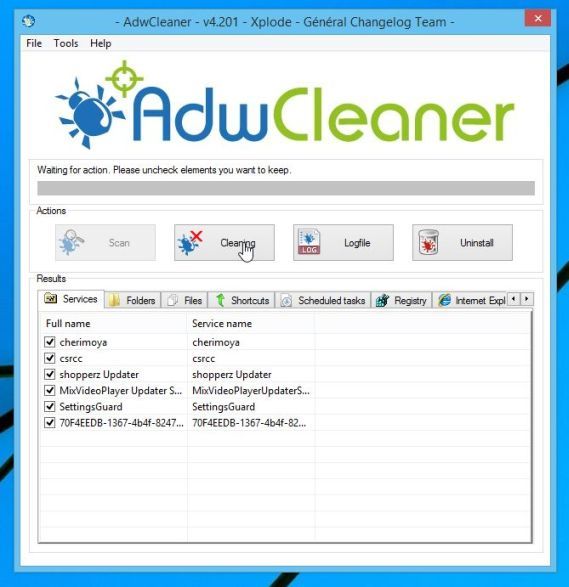











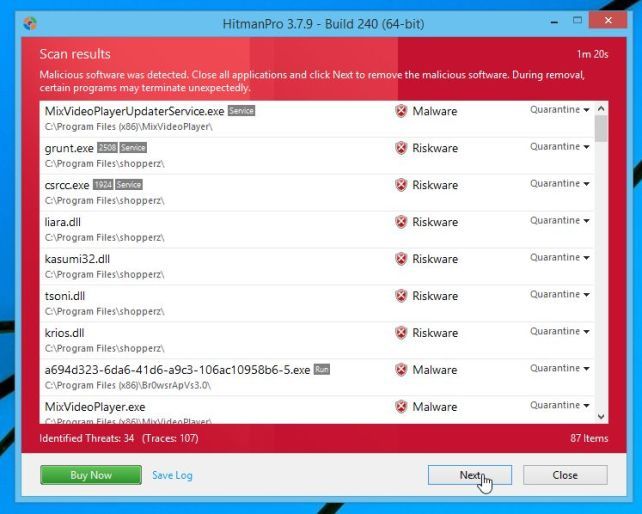

![Desktop Shortcut properties [Image: Firefox Shortcut properties]](http://malwaretips.com/blogs/wp-content/uploads/2013/02/shortcut-properties.jpg)
![Right click on browser icon from Taskbar and select Properties [Image: taskbar shortcut hijacker]](http://malwaretips.com/blogs/wp-content/uploads/2013/04/taskbar-shortcuts-hijack.jpg)
